Federal Maritime Administration
-
- SHORTSEA CRANE OPERATIONS: Lifting a Port to Prosperity Marine News, Jun 2019 #42
A Liebherr LHM 420 Crane is at the heart of a rapidly expanding shortsea shipping success story. Reliability is the key for a port that’s turned the corner, with nowhere to go but ‘up.’
Way back in January of 1996, I moved to Richmond, Virginia from Houston, Texas. Still very much in the maritime business as a cargo surveyor and ship expeditor, the Port of Richmond intrigued me, every time I drove past it on I-95. Eventually, I got a tour of the struggling port, courtesy of then port director and retired USCG Captain Marty Moynihan. Moynihan, an energetic executive, was keen to expand the port’s horizons.Back then, as much as half of the port’s meager business was tobacco shipping to and from Philip Morris, just across the street. Still, Moynihan persisted, and the port – later helped by Sean Connaughton, Virginia’s Secretary of Transportation from 2010 until 2014, and prior to that, the U.S. Maritime Administrator from 2006 until early 2009 – slowly came to life. Connaughton, then a huge supporter of shortsea shipping, put the muscle of those state and federal government positions to work, advancing the role of inland waterways in the nation’s intermodal equation.
Humble Beginnings, Great Potential
In September 2006, when Connaughton assumed the helm of the Maritime Administration, he focused on developing the foundation for a more efficient marine highway system. And, Richmond was, for this Commonwealth resident, the perfect place to start. It was slow going and the initial efforts to get a container-on-barge service up and running from the Hampton Roads area was very much a ‘chicken and egg’ proposition.Shippers were unwilling to commit to regular freight volumes and tug and barge operators on the route also struggled to make a living. Indeed, the year 2008 saw less than 150 containers moving through the port via barge. What a difference a decade can make. The Richmond Marine Terminal, as it has been rebranded, reported 29,685 box movements in 2018 alone. The terminal’s original 80-foot barge has since been replaced by another barge, the 309-foot LOA Richmond Express. A second, similar-sized barge has since joined to rotation. As many as 40 containers can fit onto each barge.
The Virginia Port Authority, eager expand opportunities for its impressive, modern Hampton Roads port complex, also knows that their intermodal operations will only be as good as the modes that follow them in the intermodal supply chain. The days of relying on trucks on the congested I-64 corridor are slowly coming to an end. One way to beat that bottleneck is to ship via rail to the Front Royal inland port, located near the confluence of Interstate highways 81 and 66. The other alternative, the Richmond Marine Terminal, reached via barge, is also becoming an increasingly popular choice for shippers.
With three barge shipments per week now the standard, and the possibility of a fourth coming very soon, reliability for this relatively obscure inland port will be everything. Virginia Ports envision the service expanding to 60,000 containers per year, or twice its current volume, something that would remove as many as 120,000 trucks off Interstate 64, along with the NOx, SOx and particulate matter associated with those engines.
None of that can happen without the crane equipment needed to quickly and safely load and unload these critical cargoes. Hence, when the Port of Virginia doubled down on their commitment to the shortsea, container-on-barge concept and extended what had been a series of five year leases to a 40-year pact, they bought – with the help of Marad – a dedicated harbor crane – the Leibherr LHM 420 version.
Meet the Leibherr LHM 420
The LHM 420 is 124 metric ton class crane and was delivered in 2016. The port purchased it mainly for container handling, the modern unit is versatile enough to efficiently handle project cargo, breakbulk and with the motor grab, bulk handling with 90 metric ton handling curve is possible, as well.In practice, the Liebherr LHM is a modular crane; hence Liebherr adopts it for each individual customer and its intended operations. In this case, it is comprised of a 2-rope machine with a rotator and spreader to handle containers, project cargo and breakbulk, as well. According to Liebherr, a 4-rope crane would also have been feasible, but typically bulk operations that predominantly handle bulk would have preferred such a configuration, so hence the 2-rope with the motor grab load chart was chosen in this instance.
The standard pad sizes were already bringing down the corner loads of the crane sufficient enough for the pier loading capacity. Hence, the adapting of the crane is quite possible, and the port can easily relocate this crane to another location in the facility.
Special features of the crane include Liebherr’s Advanced Container Control handling which allows the operator to offload the container from the barge and land it parallel to where it was picked up. Because the LHM is a revolving crane, this makes life easier for the operator as the container does not need to be repositioned.
LiebHerr Sees No Shortage of Shortsea Opportunities
The Port of Richmond may well have been the very first ‘container on barge’ effort, but it certainly won’t be the last. As Marad pushes the concept – and puts its collective money where its mouth is – shippers also have incentives to get on board. Tax credits are available for inland rail and barge service users, and many distribution centers close to both Richmond and Front royal are already taking advantage.For its part, Liebherr global footprint extends this market abroad. They’ve sold similar units to other inland facilities for similar mission sets. A Liebherr LHM 280 has been purchased in Owensboro, KY, as well as two LHM 550 units in Stockton, CA and another LHM 420 in Sacramento. CA. Overseas, Liebherr also supplies their lifting equipment to port interests on inland waterways such as the Amazonas in Brazil, and the River Magdalena and River Parana in Columbia.
Nearer to home, and as US inland rivers – from St. Louis all the way to New Orleans – heat up for ‘container-on-barge’ shortsea service, this remains a target area for Liebherr, who offer multiple different solutions. Both the LHM and FCC (Fixed Cargo Cranes) are ideal solutions for the inland rivers as is Liebherr’s floating crane range.
Advantage Richmond, Thanks in Part, to Liebherr
At Richmond Marine Terminal, local stevedores are averaging 28.5 moves per hour. And Liebherr reports that some customers and terminals are doing more, depending, of course, “on the operator, operations, conditions, how fast can containers be taken away – it’s different in every terminal.”
All that said; the Federal Maritime Administration has identified the Richmond Marine Terminal barge service as “the most successful marine highway effort in the United States.” And, once again, Marad put their money where their mouth is, recently announcing a $1.8 million grant for the James River Expansion Project on the M-64 marine highway. That’s high praise indeed, especially considering what is already happening between Baton Rouge and New Orleans. At the heart of that success is a modern and efficient container crane.This article first appeared in the June 2019 print edition of MarineNews magazine.
-
- Vessel Financing In The '90s Maritime Reporter, Sep 1994 #11
pollution and tort claims. How much insurance is enough when you have unlimited liability? Another area impacting many companies' operations is federal and state regulations such as the proposed required emissions by the EPA for vessels operating in Southern California, or the Endangered Species Act
-
 )
March 2024 - Marine Technology Reporter page: 18
)
March 2024 - Marine Technology Reporter page: 18TECH FEATURE IMR There are also weaknesses in terms of accuracy because of FiGS Operations and Bene? ts signal noise and the ability to detect small ? eld gradients. In Conventional approaches to evaluating cathodic protection this process there is a risk that possible issues like coating (CP)
-
 )
March 2024 - Marine Technology Reporter page: 11
)
March 2024 - Marine Technology Reporter page: 11assist in identifying mines and act as a neutralization device. About the Author Bottom mines pose even greater chal- David R. Strachan is a defense analyst and founder of lenges. Unlike contact mines, bottom Strikepod Systems, a research and strategic advisory mines utilize a range of sensors to
-
 )
March 2024 - Marine Technology Reporter page: 8
)
March 2024 - Marine Technology Reporter page: 8INSIGHTS SUBSEA DEFENSE Copyright RomanenkoAlexey/AdobeStock WHEN THE SHOOTING STOPS: BLACK SEA MINE CLEARANCE WILL FEATURE ADVANCED TECH, CONOPS By David Strachan, Senior Analyst, Strikepod Systems ince the beginning of the war in Ukraine, mine warfare mines have been the weapon of choice for both
-
 )
March 2024 - Marine Technology Reporter page: 6
)
March 2024 - Marine Technology Reporter page: 6MTR Editorial Advisors Gallaudet Hardy The Honorable Tim Gallaudet, Kevin Hardy is President PhD, Rear Admiral, U.S. of Global Ocean Design, Navy (ret) is the CEO of creating components and Ocean STL Consulting and subsystems for unmanned host of The American Blue vehicles, following a career
-
 )
March 2024 - Marine Technology Reporter page: 4
)
March 2024 - Marine Technology Reporter page: 4Editorial NIWA-Nippon Foundation TESMaP/ Rebekah Parsons-King www.marinetechnologynews.com ast month marked the resounding NEW YORK 118 E. 25th St., New York, NY 10010 return of Oceanology Interna- Tel: (212) 477-6700; Fax: (212) 254-6271 tional in London, perennially one Lof the world’s most important
-
 )
April 2024 - Maritime Reporter and Engineering News page: 48
)
April 2024 - Maritime Reporter and Engineering News page: 48Index page MR Apr2024:MN INDEX PAGE 4/5/2024 1:33 PM Page 1 ANCHORS & CHAINS MILITARY SONAR SYSTEMS tel:+44 (0) 1752 723330, [email protected] , www.siliconsensing.com Anchor Marine & Supply, INC., 6545 Lindbergh Houston, Massa Products Corporation, 280 Lincoln Street, SONAR TRANSDUCERS
-
 )
April 2024 - Maritime Reporter and Engineering News page: 43
)
April 2024 - Maritime Reporter and Engineering News page: 43“The industry is an ecosystem which includes owners, managers, mariners, shipyards, equipment makers, designers, research institutes and class societies: all of them are crucial,” – Eero Lehtovaara, Head of Regulatory & Public Affairs, ABB Marine & Ports All images courtesy ABB Marine and Ports provi
-
 )
April 2024 - Maritime Reporter and Engineering News page: 42
)
April 2024 - Maritime Reporter and Engineering News page: 42OPINION: The Final Word Seeing the Ship as a System Shipping must engage with the decarbonization realities that lie ahead by changing the way it crafts maritime legislation to re? ect its place in the interconnected, interdependent world economy, said Eero Lehtovaara, ABB Marine & Ports. ABB Marine &
-
 )
April 2024 - Maritime Reporter and Engineering News page: 41
)
April 2024 - Maritime Reporter and Engineering News page: 41Nautel provides innovative, industry-leading solutions speci? cally designed for use in harsh maritime environments: • GMDSS/NAVTEX/NAVDAT coastal surveillance and transmission systems • Offshore NDB non-directional radio beacon systems for oil platform, support vessel & wind farm applications
-
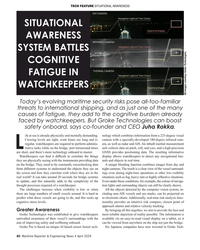 )
April 2024 - Maritime Reporter and Engineering News page: 40
)
April 2024 - Maritime Reporter and Engineering News page: 40TECH FEATURE SITUATIONAL AWARENESS SITUATIONAL AWARENESS SYSTEM BATTLES COGNITIVE FATIGUE IN WATCHKEEPERS All images courtesy Groke Technologies Today’s evolving maritime security risks pose all-too-familiar threats to international shipping, and as just one of the many causes of fatigue, they add
-
 )
April 2024 - Maritime Reporter and Engineering News page: 39
)
April 2024 - Maritime Reporter and Engineering News page: 39Tech Files Latest Products, Systems and Ship Designs “Wall Climbing Robot” Danish Pilot calls gets ClassNK Nod LEGO Model "A tribute build to a work life at sea" Image courtesy MOL, Sumitomo Heavy Industries lassNK granted its Innovation Endorse- Image courtesy Espen Andersen/DanPilot ment for
-
 )
April 2024 - Maritime Reporter and Engineering News page: 38
)
April 2024 - Maritime Reporter and Engineering News page: 38Tech Files Latest Products, Systems and Ship Designs Zero-Emission Mooring Service of a Tanker Consulmar achieved a milestone by executing what it calls ing boat Castalia, which operates on full electric propulsion. the world's ? rst zero-emissions mooring service for a tanker. Equipped with two 150 kW
-
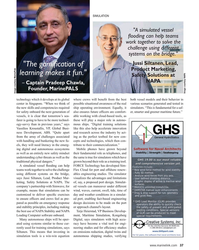 )
April 2024 - Maritime Reporter and Engineering News page: 37
)
April 2024 - Maritime Reporter and Engineering News page: 37SIMULATION "A simulated vessel ? ooding can help teams work together to solve the challenge using different systems on the bridge." – Jussi Siltanen, Lead, "The gami? cation of Product Marketing, learning makes it fun." Safety Solutions at NAPA – Captain Pradeep Chawla, Founder, MarinePALS Image
-
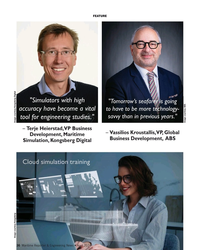 )
April 2024 - Maritime Reporter and Engineering News page: 36
)
April 2024 - Maritime Reporter and Engineering News page: 36FEATURE "Simulators with high "Tomorrow’s seafarer is going accuracy have become a vital to have to be more technology- savvy than in previous years." tool for engineering studies." Image courtesy ABS – Terje Heierstad, VP Business – Vassilios Kroustallis, VP, Global Development, Maritime Business
-
 )
April 2024 - Maritime Reporter and Engineering News page: 35
)
April 2024 - Maritime Reporter and Engineering News page: 35SIMULATION e have a close relationship with tech- Realism is prized beyond immersive, photo-realistic visu- nology, evidenced by, for example, als, and providers are introducing increasingly accurate func- the phones we are estimated to un- tionality. FORCE Technology’s upcoming DEN-Mark2 math- lock around
-
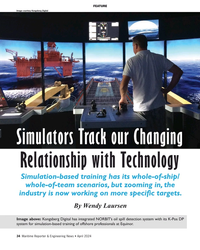 )
April 2024 - Maritime Reporter and Engineering News page: 34
)
April 2024 - Maritime Reporter and Engineering News page: 34FEATURE Image courtesy Kongsberg Digital Simulators Track our Changing Relationship with Technology Simulation-based training has its whole-of-ship/ whole-of-team scenarios, but zooming in, the industry is now working on more speci? c targets. By Wendy Laursen Image above: Kongsberg Digital has integrated
-
 )
April 2024 - Maritime Reporter and Engineering News page: 32
)
April 2024 - Maritime Reporter and Engineering News page: 32FEATURE A closeup of a blade installation process taken via drone. A blade handling system is apparent (in yellow). Images courtesy of Mammoet requirement for the development of these cranes, particularly ling area. This would result in a major time and fuel saving. in ? oating offshore wind,” says
-
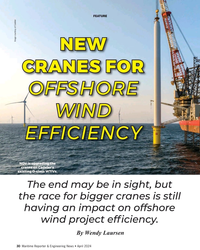 )
April 2024 - Maritime Reporter and Engineering News page: 30
)
April 2024 - Maritime Reporter and Engineering News page: 30FEATURE Image courtesy of Cadeler NEW CRANES FOR OFFSHORE WIND EFFICIENCY NOV is upgrading the cranes on Cadeler’s existing O-class WTIVs. The end may be in sight, but the race for bigger cranes is still having an impact on offshore wind project ef? ciency. By Wendy Laursen 30 Maritime Reporter
-
 )
April 2024 - Maritime Reporter and Engineering News page: 28
)
April 2024 - Maritime Reporter and Engineering News page: 28FEATURE INTERVIEW track missiles and warheads for the Mis- sile Defense Agency, and it travels with its support ship, the MV Hercules. For our Service Support ships, we have the two hospital ships, USNS Mer- cy and Comfort; two rescue and salvage ships; two submarine tenders; and the Sixth Fleet ?
-
 )
April 2024 - Maritime Reporter and Engineering News page: 27
)
April 2024 - Maritime Reporter and Engineering News page: 27RADM PHILIP SOBECK, MILITARY SEALIFT COMMAND With COVID, we had to make some hard choices for our Do your CIVMARs have upward mobility? mariners because we couldn’t rotate. Many of our mariners The Navy has Sailors who become “Mustangs,” and work found other employment, and were able to use their skills
-
 )
April 2024 - Maritime Reporter and Engineering News page: 26
)
April 2024 - Maritime Reporter and Engineering News page: 26FEATURE INTERVIEW “Over the next decade, 12 new classes of ships will come online and MSC will see up to 20 new ships deliver to the ? eet in the next ? ve years. This includes new oilers, towing, salvage and rescue tugs, and expeditionary fast transports and emergency medical ships. A large
-
 )
April 2024 - Maritime Reporter and Engineering News page: 25
)
April 2024 - Maritime Reporter and Engineering News page: 25RADM PHILIP SOBECK, MILITARY SEALIFT COMMAND Photo by Brian Suriani USN Military Sealift Command From a global supply chain perspective, What makes MSC so vital to the we’ve learned a lot about dealing with Navy’s ? eet and our military disruptions. COVID delivered a big forces around the world? wake-up
-
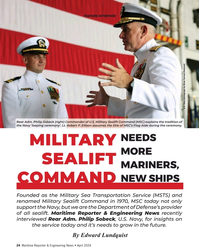 )
April 2024 - Maritime Reporter and Engineering News page: 24
)
April 2024 - Maritime Reporter and Engineering News page: 24FEATURE INTERVIEW U.S. Navy photograph by Brian Suriani/Released Rear Adm. Philip Sobeck (right) Commander of U.S. Military Sealift Command (MSC) explains the tradition of the Navy ‘looping ceremony’. Lt. Robert P. Ellison assumes the title of MSC’s Flag Aide during the ceremony. NEEDS MILITARY MORE
-
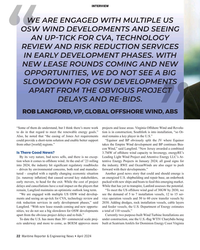 )
April 2024 - Maritime Reporter and Engineering News page: 22
)
April 2024 - Maritime Reporter and Engineering News page: 22INTERVIEW WE ARE ENGAGED WITH MULTIPLE US OSW WIND DEVELOPMENTS AND SEEING AN UP-TICK FOR CVA, TECHNOLOGY REVIEW AND RISK REDUCTION SERVICES IN EARLY DEVELOPMENT PHASES. WITH NEW LEASE ROUNDS COMING AND NEW OPPORTUNITIES, WE DO NOT SEE A BIG SLOWDOWN FOR OSW DEVELOPMENTS APART FROM THE OBVIOUS
